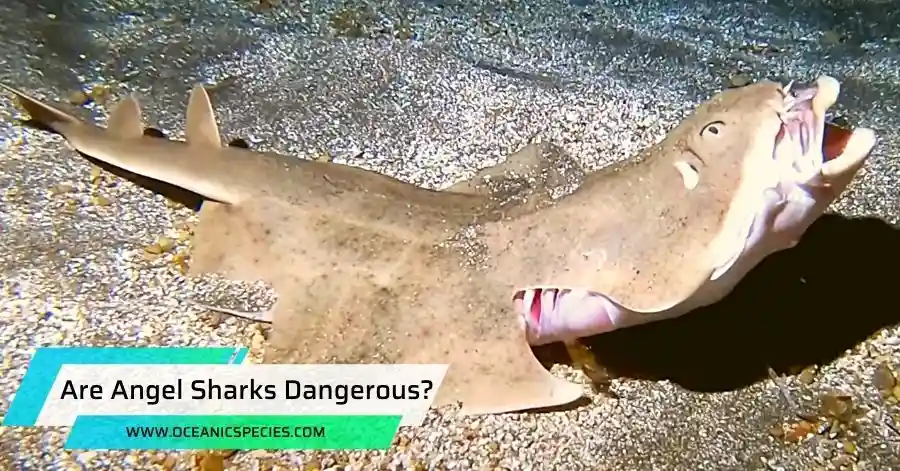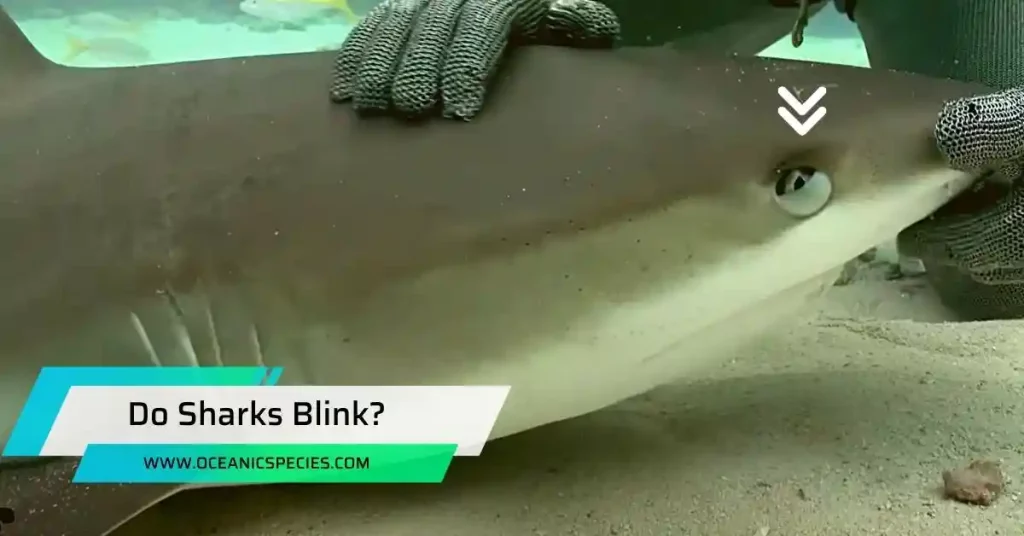Angel sharks are generally not dangerous to humans, but they can bite if provoked. Angel sharks are flat-bodied cartilaginous fishes found in the oceans around the world.
With their camouflaged appearance and lying partially buried in the sand, they blend well with their surroundings. Despite their docile nature, angel sharks have sharp teeth and can deliver a painful bite if they feel threatened or provoked.
It is important to give these creatures space and respect their natural habitat to avoid any potential incidents.
Understanding Angel Sharks And Their Behavior
While their appearance may seem intimidating, they are not typically dangerous to humans. Understanding their behavior can help us appreciate their presence in our oceans.
In this section, we will delve into the description of angel sharks, their physical characteristics, as well as their habitat and distribution.
Description Of Angel Sharks

Angel sharks belong to the family squatinidae, which comprises around 26 species. They are known for their flattened bodies and broad pectoral fins, resembling angel wings. These sharks possess a remarkable ability to camouflage themselves, blending into the sandy or muddy ocean floor effortlessly. With their protruding eyes and flattened snouts, angel sharks possess a distinct appearance that sets them apart from other shark species.
Physical Characteristics
- Size: Angel sharks can vary in size, ranging from smaller species measuring around 3 feet to larger species exceeding 6 feet in length.
- Weight: Depending on the species, these sharks can weigh anywhere from 40 pounds to over 100 pounds.
- Coloration: Their coloration helps them blend seamlessly with their surroundings, often featuring shades of brown, gray, or sandy tones.
- Teeth: While their teeth may not be as sharp or menacing as those of other shark species, angel sharks possess multiple rows of small, pointed teeth that aid in capturing prey.
- Ventral side: The underside of the angel shark is typically light in color, allowing them to disguise themselves from predators when viewed from below.
Habitat And Distribution
- Habitat: Angel sharks are primarily found in temperate, subtropical, and tropical seas across the world.
- Ocean floor dwellers: These sharks prefer sandy or muddy ocean bottoms and are often found at depths ranging from 100 to 1,500 feet.
- Coastal areas: They can also frequently be encountered in shallow coastal areas, such as bays and estuaries.
- Distribution: Angel sharks have a widespread distribution, inhabiting various regions from the eastern pacific ocean (off the coast of north and south america) to the mediterranean sea, as well as the indian and pacific oceans.
Assessing The Potential Danger Of Angel Sharks

While angel sharks may have an intimidating name, the question remains: are angel sharks dangerous? In this section, we will delve into the potential danger associated with these unique marine creatures and explore historical incidents, rare attacks on humans, and the contributing factors.
Rare Attacks On Humans
Genuine encounters with angel sharks posing a threat to humans are extremely rare.In fact, these creatures are known for their docile nature and non-aggressive behavior towards humans.
While there have been a few reported cases of human encounters with angel sharks, they are predominantly accidental and not intentional acts of aggression.
It is important to note that angel sharks are seldom the instigators of these incidents, as they typically resort to camouflage and bury themselves on the seafloor, allowing unsuspecting prey to swim within striking distance.
Historical Incidents
Throughout history, documented attacks involving angel sharks have been scarce and relatively minor. A few isolated incidents involve divers or fishermen accidentally stepping on or disturbing buried angel sharks, triggering defensive reactions.
These incidents have resulted in minor injuries such as cuts or abrasions, but none have been fatal. However, it is essential to exercise caution and respect these creatures’ natural habitat to avoid any potential encounters.
Factors Contributing To Attacks
- Human behavior and environmental conditions often contribute to any potential encounters or incidents with angel sharks.
- Inquisitive divers or fishermen who provoke, touch, or disturb angel sharks increase the likelihood of defensive reactions and potential harm.
- Water visibility, including poor lighting conditions or murky waters, can also heighten the chances of accidental encounters, especially if divers or swimmers unknowingly stumble upon a concealed angel shark.
- Furthermore, unfamiliarity with angel sharks can lead to undetected interactions, as their flattened bodies and incredible ability to blend into surroundings make them challenging to spot.
Human Interaction And Safety Measures
Angel sharks are generally non-aggressive and pose little threat to humans. However, it is important for beachgoers and the public to be aware of safety measures and guidelines when encountering these fascinating creatures. In this section, we will discuss angel shark conservation efforts, important do’s and don’ts for beachgoers, and the necessity of educating the public about angel sharks’ behavior.
Do’S And Don’Ts For Beachgoers:
Do: If you encounter an angel shark while snorkeling or diving, maintain a calm and non-threatening demeanor. Observe from a safe distance, as they may feel threatened by close proximity.
Do: Respect their natural environment. Refrain from touching or feeding angel sharks as this can disrupt their behavior and survival instincts.
Do: Report any angel shark sightings to relevant local authorities or conservation organizations. This information is valuable for ongoing research and helps contribute data to conservation efforts.
Don’t: Never attempt to provoke or harass an angel shark, as this can lead to defensive reactions.
Don’t: Avoid using flash photography or excessive bright lights when observing angel sharks as they have sensitive eyes and may be disturbed by sudden bursts of light.
Educating The Public About Angel Sharks’ Behavior:
- Awareness campaigns: It is crucial to educate beachgoers and the general public about the importance of conserving angel sharks and their habitats. Awareness campaigns through social media, nature documentaries, and public events can help spread knowledge about these amazing creatures.
- Understanding their behavior: Providing information about angel sharks’ behavior, such as their feeding habits, mating rituals, and preferred habitats, can help people better comprehend their role in the ecosystem and how to interact with them safely.
- Promoting responsible ecotourism: Educating tourists and visitors about responsible ecotourism practices, including respectful behavior towards marine life, can significantly reduce negative impacts on angel sharks and their environment.
Angel Sharks Vs Other Marine Species: A Comparative Analysis
In this section, we’ll explore how angel sharks stack up against other marine creatures, shedding light on their reputation and behavior.
Shark Species With Higher Attack Rates:
- Great white sharks: These fierce predators have earned a fearsome reputation for a reason. With a higher attack rate, they are known for their powerful jaws and incredible hunting prowess.
- Tiger sharks: Equally formidable, tiger sharks are known for their opportunistic feeding habits, partly contributing to their higher attack rates compared to angel sharks.
- Bull sharks: Notorious for their aggressive nature, bull sharks have been implicated in many attacks due to their presence in both coastal and freshwater environments.
Angel Sharks’ Coexistence With Other Species:

Despite being sharks, angel sharks possess characteristics that differentiate them from their more aggressive counterparts. Here’s how they interact with other marine species:
- Non-aggressive behavior: Angel sharks are generally docile and non-threatening toward other species. They prefer to rely on camouflage, rather than aggression, to avoid potential conflicts.
- No direct threats to humans: Angel sharks tend to avoid areas frequented by humans, reducing the risk of accidental encounters. They are unlikely to perceive humans as prey due to their preferred diet of bottom-dwelling creatures.
- Camouflage tactics: These skilled masters of disguise blend seamlessly into their environment, making them unlikely to be perceived as a threat or target by other marine species.
Angel Sharks In Popular Culture And Media
From movies and tv shows to misconceptions and accurate representation, let’s explore the portrayal of angel sharks in various forms of entertainment and the importance of promoting their accurate depiction.
Common Misconceptions Versus Reality
It’s crucial to separate fact from fiction when it comes to angel sharks. Here are some common misconceptions and the reality behind them:
Misconception: Angel sharks are deadly and pose a significant threat to humans.
Reality: While angel sharks are carnivorous, they are generally unaggressive and prefer to avoid confrontation. They are not known to attack humans unless provoked or disturbed.
Misconception: Angel sharks are exclusively found in tropical waters.
Reality: Angel sharks can be found in a variety of marine habitats, including both tropical and temperate coastal areas. Their distribution spans across the atlantic and pacific oceans.
Misconception: Angel sharks are related to stingrays.
Reality: Despite their similar flattened body shape, angel sharks belong to the shark family, not the ray family. They have distinct differences in anatomy and behavior.
Frequently Asked Questions
How Rare Are Angel Sharks?
Angel sharks are considered rare, with some species being listed as critically endangered. Human activities such as fishing and habitat destruction have greatly impacted their numbers. These unique flat-bodied predators are now being protected to ensure their survival in the wild.
Are Angel Sharks Docile?
Yes, angel sharks are generally docile. They tend to be non-aggressive and are not considered a threat to humans.
Are Atlantic Angel Sharks Dangerous?
No, atlantic angel sharks are not considered dangerous to humans. They are typically docile and pose little threat.
How Do Angel Sharks Behave?
Angel sharks are bottom-dwelling creatures that prefer to lie partially buried in the sand or mud. They are ambush predators, patiently waiting for prey to swim close before lunging forward and capturing it. They have a flattened body shape and large pectoral fins that help them blend into the seafloor and maneuver quickly when necessary.
Are Angel Sharks Dangerous To Humans?
Angel sharks are generally not dangerous to humans. They are known to be docile creatures and typically avoid human contact.
Conclusion
It is important to understand that while angel sharks may have a formidable appearance, they are generally not considered dangerous to humans. These unique creatures are more likely to retreat or hide when confronted rather than engage in aggressive behavior.
It is crucial to respect their natural habitats and avoid unnecessary interactions in order to ensure their continued survival. These graceful creatures have evolved over millions of years to be apex predators in their ecosystems, and it is our responsibility to protect and conserve their populations.





